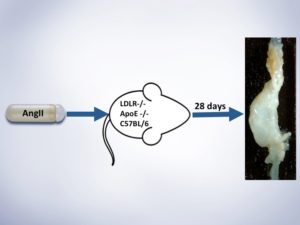Aortic aneurysms are pathological dilations with high risk of mortality due to rupture. Abdominal aortic aneurysms (AAA) are the most common form of this condition with the dilation being mainly present in the infrarenal region. Histological analysis of human AAA tissue have shed lights on pathological hallmarks of AAAs, however, such tissues are acquired at the advanced stages of the disease and do not provide clear information about the AAA initiation. Therefore, the research has relied extensively on AAA animal models to better define the underlying mechanism of AAA. In general, there are three main mouse models to study AAA: 1) perfusion of elastase into the infrarenal aorta, 2) periaortic application of calcium chloride, or 3) subcutaneous infusion of Angiotensin (Ang) II. The purpose of this blog post is to provide a short description about the AngII-induced AAA.
AngII is the major bioactive peptide of the renin-angiotensin system. The AngII-induced AAA model is probably the most commonly used animal model nowadays, which was developed at the University of Kentucky. In this model, a small osmotic mini pump is subcutaneously implanted in the animal, which will infuse AngII (mainly at the dose of 1,000 ng/kg/min) for 28 days. AngII-induced AAA is augmented by hypercholesterolemia; therefore, ApoE-/- and LDLr-/- mice are the two most common animal models used for AngII-induced AAA studies. AngII also induces AAA in normolipidemic mice, however, at much lower incidence. The AngII-induced AAA formation is independent of the modestly increased systolic blood pressure after AngII infusion and the AAA induced by chronic AngII infusion is mainly located at suprarenal aortic region. This model exhibits progressive luminal expansion, increased leukocytic infiltration, elastin fiber disruption, loss of extracellular matrix, and consequently, aortic wall remodeling – all of which are hallmarks of human AAA.

Although AngII-infused mouse models are very popular due to similarities to human AAA and reproducibility, difficulties in breeding mice to a hypercholesterolemic background has hampered its wide use. However, a recent study from our laboratory provided a rapid approach for increasing plasma cholesterol and Ang II–induced AAA incidence in C57BL/6 mice by applying a gain-of-function mutation of mouse PCSK9 protein using an adeno-associated viral method.
Aortic aneurysms are lethal asymptomatic conditions and thanks to development of animal models, considerable increase in research on aneurysm pathogenesis have shed lights on the undelaying mechanisms of the disease. Despite the progress, there are still many perplexities regarding the AAA initiation and development, and this uncertainty highlights the important of understanding the mouse models to further research this devastating condition.
Resources for Further Reading:
- Renin-Angiotensin System and Cardiovascular Functions
Chia-Hua Wu, Shayan Mohammadmoradi, Jeff Z. Chen, Hisashi Sawada, Alan Daugherty and Hong S. Lu, ATVB, 2018 - Hypercholesterolemia Induced by a PCSK9 Gain-of-Function Mutation Augments Angiotensin II–Induced Abdominal Aortic Aneurysms in C57BL/6 Mice—Brief Report
Hong Lu, Deborah A. Howatt, Anju Balakrishnan, Mark J. Graham, Adam E. Mullick, and Alan Daugherty, ATVB, 2016